Category: Travel
It’s time for some game theory, United Airlines edition
I agree the man should have left the plane in the first place, the police should not have used violence, the CEO should have apologized right away, United (possibly) should have known earlier it needed to transport the employees, and a bunch of other things. Perhaps United should have mimicked Ryan Air and charged people fifteen euros (or much more!) for dragging them off the flight. But let’s put that behind us and consider some analysis:
The priority of all other confirmed passengers may be determined based on a passenger’s fare class, itinerary, status of frequent flyer program membership, and the time in which the passenger presents him/herself for check-in without advanced seat assignment.”
There is also an exception for disabilities.
From the passenger’s point of view, this operates like randomization, as customers were told “the computer will decide.” An alternative of course is to eliminate the random shuffle and require cash payments to passengers no matter what, waiting until someone volunteers to give up his or her seat at the required high price.
One problem with using money to buy people out of queues is that it encourages more upfront queuing to begin with, and that involves negative externalities for passengers as a whole. In any model of stochastic demand and fixed capacity in the short run, demand will sometimes be too high, and I don’t know of many retail markets that rely on price alone to ration quantity. Given that reality, I am not sure why everyone is insisting the airlines should do things this way. If Nordstrom starts to run out of their blue cooking pots on the day of the sale, so be it, they don’t raise the price toward the end of the day as supplies dwindle. Paying $5 to each denied pot-buyer just ensures they are more likely to run out of pots the next time around.
You could spend many moons debating whether price-only solutions to short-run shortages lead to higher or lower upfront prices (and thus higher or lower deadweight loss) than price + quality adjustment solutions to short-run shortages. As far as I know, this question hasn’t been settled, and quality adjustment is well-known as a means of enabling more upfront price discrimination. If nothing else, it pushes more people into business class. The subtler mechanism is that the airlines have plenty of reasons to favor their more loyal customers, if only because of market segmentation, and this is one of them. The market segmentation effects brings more collusion, and higher prices, but the price discrimination effect tends to boost output.
To consider possible analogies, let’s say it was a queue to buy concert tickets, with more people in line than seats for the show. One option is to give cash to those who can’t get tickets, rather than just turning them away, but I’ve never heard anyone argue this would be efficient. The cash payments are a tax on product supply and also they encourage too much queuing in the first place. Instead we send some people home without tickets, even if they have waited in line for a long time. In essence, randomization is one factor behind who is sent home without a ticket, because no arrival, when deciding whether or not to show up, knows exactly how many other people will have been prior in line. Don’t be surprised if the airlines sometimes use a similar system.
As Garett Jones points out, sometimes the ATM runs out of cash and you don’t get any bonus afterwards. There are plenty of other examples.
Maybe United should allow for a secondary market for the doctor to stay on the plane by buying flying rights from some other passenger, one who wouldn’t take the United offer but who might take the doctor’s better offer. That idea is worth consideration, though arranging the contract could be tricky unless the passengers belong to a common system with pre-arranged arbitration in place (Facebook could run it? PayPal?) With tickets this kind of resale works smoothly through StubHub and the like. (By the way, once the guy proclaimed he was a doctor going to see his ailing patients, did any of the other passengers offer to get off instead? Hmm…)
The “re-accommodation” seems much worse to many people because the doctor already was seated. An endowment effect argument therefore might require that the airline use a full auction once seats are taken. That would increase the incentive of the airline to spot demand-supply imbalances in advance of boarding, and it might well be a good idea. On the other hand, the presence of an endowment effect can help make “removal” an especially effective pre-emptive demand tax in world-states of potential excess demand. The more you hate being removed from your seat, the fewer people have to be removed to achieve a greater S-D balancing ex ante. Furthermore, the highest valuation buyers will make sure to be loyal buyers, which presumably is what the airline wants.
The cynical, who have studied randomization in optimal tax theory (that is not I, I love human rights too much and spent my youth reading the Salamancans), would even say that the higher value are the trips, and the more people fear being manhandled, the more it makes sense to use stochastic pain as a deterrent for overbooking. Think of it as a way to increase the degree of ex ante price discrimination, and limit cross-buyer externalities, at minimal cost in terms of actual output.
Finally, the United episode gets at a more general problem with algorithms. Even if the selection of seat loser is “truly random,” it will not always look random to the outside world. The bumping of the doctor has been a huge event on Chinese social media, and how many of those Chinese are thinking that the doctor was bumped because he was Chinese. The international loss of reputation here is significant, and it damages the United States as a whole, not just United as a brand name. In essence, individual companies under-invest in perceptions of fairness, and reliance on “truly random” algorithms can make this worse rather than better. A deliberate human chooser might well have done better, if only by knowing that a public defense of the choice would have been required, and that might have nudged United back toward the full auction or some other solution. In essence, companies may be oversupplying “reliance on randomness,” not taking the collective negative externality into account. Counterintuitively, relying on algorithms can increase perceptions of unfairness, and many of the costs of unfairness come on the perceptions side, even if “the true model” is making choices using a fair process.
Two other factors are worth considering. First, due to social media it will be increasingly difficult to write and enforce retail contracts with legal meanings very different from their “common sense” meanings. Maybe I’ll write a separate post on whether that will raise or lower transactions costs, but I suspect a bit of both.
Second, given that the stock of United tanked after the incident, now airline customer service will improve rather rapidly. In the long run of course that will translate into higher prices too, so the net effect of this shift will prove regressive. The more you complain, the more you are redistributing wealth — through the medium of preferred price-quality configurations — away from lower earners and toward the wealthy.
I’m not saying that the United rules are efficient, either generally or in this particular case, but I do see many people not even willing to ask the question of under what conditions they might be efficient. And that is indeed to correct way to start on analyzing this problem.
Addendum: This is also a story of price controls, on that let’s turn the microphone over to Air Genius Gary Leff:
More importantly, United didn’t do it because Department of Transportation regulations set maximum required compensation for involuntary denied boarding (in this case 4 times the passenger’s fare paid up to a maximum of $1350). So they’re not going to offer more than that for voluntary denied boardings, especially since the violent outcome here wasn’t expected and the United Express gate agent had no authority to do more.
China train fact of the day
The first China-bound cargo train carrying British products left London on Monday for an eastern Chinese city, highlighting another historic moment in the China-initiated Belt and Road Initiative.
The cross-continent freight, loaded with 32 containers carrying products including milk powder and soft drinks, left from east London’s DP World gateway for the Chinese city of Yiwu amid cheers and applause.
The front of the red locomotive was seen with a sign board that reads “First London-Yiwu Train.”
The 12,000-km journey will pass through nine countries in 18 days. During the trip, the train’s locomotives have to be changed due to different railway gauges in the countries.
Here is the article, via George Chen.
The Hijra of India
Driving around Mumba one sometimes sees hijra begging at street intersections. The Indian term hijra is typically translated as eunuch but not all hijra are eunuchs or even want to be eunuchs so the term transgender is more accurate. In India, transgendered people are discriminated against, widely disliked, and feared. At the same time their blessings are sometimes sought after on important occasions.
 It’s common for a transgendered person to be abandoned and thrown out of their home. Most then come to live in small communes of hijra headed by a guru and served by chelas (disciples/students).
It’s common for a transgendered person to be abandoned and thrown out of their home. Most then come to live in small communes of hijra headed by a guru and served by chelas (disciples/students).
We chelas must work hard, do the cooking inside the house, and most of the dancing outside. We have an obligation to look after our guru when she grows old, just like we would look after our own mother. In return, when we first become hijras our Chaman Guru teaches us chelas the way of the eunuchs.
(The quote is from William Dalrymple’s wonderful book, City of Djinns: A Year in Delhi. Dalrymple, however, draws too close a connection between hijra and the kind of eunuchs who were forcibly created to guard harems among the Mughals).
The communes of 5-15 hijras are like families but also like firms. The hijra make money by begging and by blessing weddings and births. The guru’s job is to learn the time and place of such celebrations for which she develop informants among midwives, musicians and caterers. A supra-community of hijra divide each city into exclusive territories. Each guru thus has a local monopoly and any hijra thrown out by her guru forfeits the right to work. A hijra thus has little choice but to work as a chela especially since other avenues of work are closed. Thus, the guru is both mother, father and boss.
The woman in the guru makes him feel motherly toward his chelas, but the man in him makes him authoritarian and dictatorial.
The blessings of the hijra are always double-edged. When are the blessed paying for the blessing and when are they are paying for the hijra not to curse them or just to go away? The hijra are not above embarrassing your wedding guests with bawdy and rude behavior.
Times have never been easy for the hijra but times are especially tough now because only the traditional occupations are open to them yet fewer people today believe in either their blessings or their curses. Many people consider them a nuisance. As a result, earnings are down.
Our main occupation is to perform badhai at weddings, or when a child is born. At such times we sing and dance to bless the newlyweds or the newborn. But can badhai alone fill our stomachs? Obviously not, and so we supplement our earnings by begging on city streets, and performing sex work, and dancing in bars and night clubs. Dancing comes naturally to us hijras.
…We are thus destitute. Estranged from family and ostracized by society, people couldn’t care less how we earn a livelihood, or where our next meal comes from. If a hijra commits a crime, the mob rushes to attack him while the police are only too glad to press charges against him. This is not to justify crime, but to reiterate that all crimes have a social dimension, and in the case of hijras this cannot be overlooked. Yet it is never taken into account.
A small trans and hijra empowerment movement works to bring greater acceptance to allow hijra to move into other occupations. On Sunday, I attended a hijra festival. The hijra were sweet and welcoming when I talked with them but it was not well attended.
The movement has found success among India’s liberal “internationalized” elite. India’s Supreme Court, for example, recognized a third gender in 2014, so Indian passports, driver’s licenses and other official documents now include M, F and an Other category. Gay sex, however, is still against the law (although prosecutions are rare to nonexistent). It’s notable that Bangladesh and Pakistan, two other countries not known for their liberalism, also recognize a third gender. The seeming contradiction is in part because sexual categories are different than in the West so, for example, sex between men and the third gender (hijra) isn’t considered sex between two men. As is true everywhere, all these issues are complicated and contested.
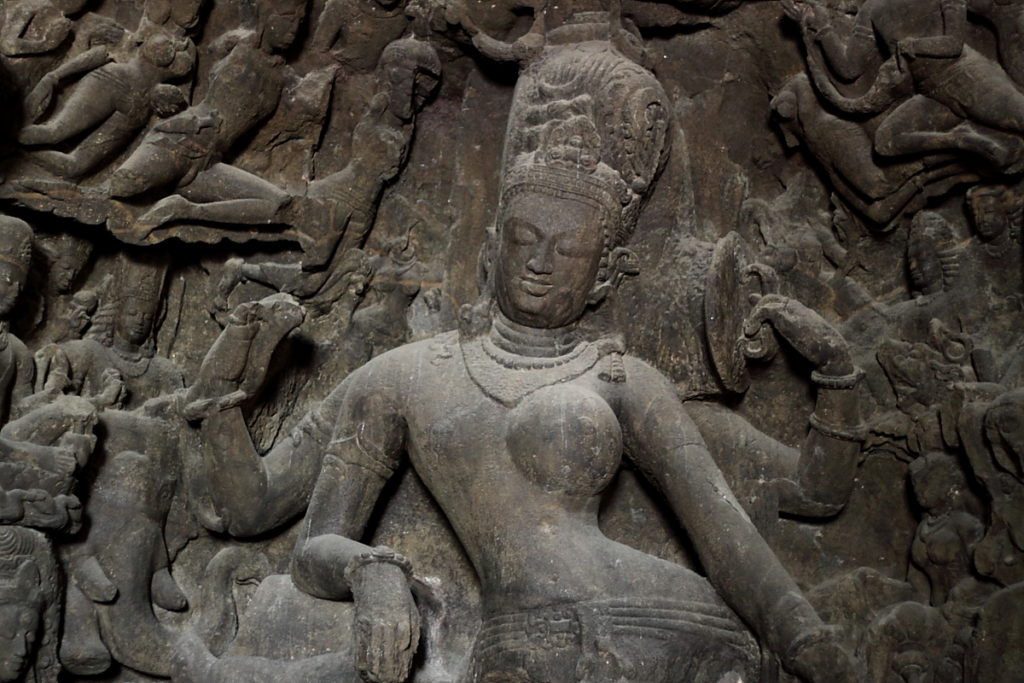 Intellectuals can also find support for the third gender in Hindu culture. The Vedas, for example, refer to Tritiya prakrti, people of the third sex, and the major Hindu texts treat homosexuality as normal, or at most give it mild admonishments. Hindu gods will often be reincarnated in different genders or even as hermaphrodites (the sculpture at Elephanta island near Mumbai shown at left depicts a hermaphrodite reincarnation of Shiva). The famous erotic carvings at the Khajuraho temples and elsewhere include depictions of homosexual sex.
Intellectuals can also find support for the third gender in Hindu culture. The Vedas, for example, refer to Tritiya prakrti, people of the third sex, and the major Hindu texts treat homosexuality as normal, or at most give it mild admonishments. Hindu gods will often be reincarnated in different genders or even as hermaphrodites (the sculpture at Elephanta island near Mumbai shown at left depicts a hermaphrodite reincarnation of Shiva). The famous erotic carvings at the Khajuraho temples and elsewhere include depictions of homosexual sex.
The relative tolerance of the Hindu classics leads some people to blame Islamic and British influences on Indian society for it’s intolerance but discrimination against the Hijra is widespread. Although intellectuals may find support for tolerance in Hindu classics, the folk do not. Indians by and large are embarrassed about Khajuraho’s depiction of heterosexual sex, let alone anything more challenging.
The willingness of trans and hijra, both in India and the West, to live with discrimination and abandonment is testament to the great drive to live as one feels one is. I wish the hijra good fortune.
Hat tip: Kshitij Batra for discussion.

Today is a good day to remember the great Julian Simon
Today is a good day to remember the great Julian Simon. Here’s a piece on just one of his many accomplishments.
Julian Simon helped revolutionize the airline industry by popularizing the idea that carriers should stop randomly removing passengers from overbooked flights and instead auction off the right to be bumped by offering vouchers that go up in value until all the necessary seats have been reassigned. Simon came up with the idea for these auctions in the 1960s, but he wasn’t able to get regulators interested in allowing it until the 1970s. Up until that time, Litan writes, “airlines deliberately did not fill their planes and thus flew with less capacity than they do now, a circumstance that made customers more comfortable, but reduced profits for airlines.” And this, of course, meant they had to charge passengers more to compensate.
By auctioning off overbooked seats, economist James Heins estimates that $100 billion has been saved by the airline industry and its customers in the 30-plus years since the practice was introduced.
Moving to China and how to do it
I’m planning on…spending the summer in China before starting the program in Beijing in September…How much emphasis should I spend generally on language study vs. travel in China vs. reading in English about the country? For this summer, I was thinking of holing up in one city and finding tutors to do 10hrs/day of study, traveling around the country, or some combination of the two.Here’s how one blogger described what three months of intensive gave him: “My level of Chinese is sufficient to deal with most basic necessities of living, travel, make new friends and have interesting conversations entirely in Chinese. I can also read most of simple emails, menus and signs, although my reading still lags behind my speaking ability. I’m still not at a level where I could easily understand group conversations, movies, television or read books or newspapers.”Also, any cities in particular you’d like to spend three months in?What type/mix of books should I be reading over the next few months in the states to prep? Any particular titles come to mind?Ideas for Master theses in economics that would benefit from being in-country even with relatively limited language ability?
TC here: Tough questions! I would offer a few points:
1. You can’t study a foreign language for ten hours a day, as you need to intersperse more rewards to keep yourself motivated (like most things!). The best way to learn Chinese is how I learned German, namely through a romantic partner. That probably implies having a home base city for a big chunk of your time.
2. You need to ask how well you can handle air pollution, especially for the winter months. Overall, I prefer Western China, which also tends to be less polluted. Yunnan province is to me one of the very best visits in the world, and the environment there is downright pleasant, but everywhere I’ve gone in China was worth visiting. Of course Beijing, Shanghai, and Shenzhen are where much of the action is at, of those three I enjoy Beijing the most (by far) but would pick Shanghai to live, mostly because it has less air pollution.
3. It is hard to tackle China through books, and single titles don’t get you very far (but here are a few recommendations). Maybe start with John Keay for an overview, but finish up by reading it yet again. Along the way, pick a few particular pre-communist topics, such as the Taiping rebellion, the history of a part of the country, Christianity in China, the Great Divergence, or the Grand Canal (understudied!), rather than just pawing through dozens of basically similar books on “where China is at right now.” If I had to suggest one topic, maybe it would be “reading Chinese history through the lens of the state capacity idea,” as my colleague Mark Koyama has been working on.
4. The economic history of China is an area where economics research is making some very rapid advances from a pretty low base of knowledge.
5. Ask someone who has moved to China.
The Uttar Pradesh Association of Dead People
The amazing story of Lal Bihari, founder of the Uttar Pradesh Association of Dead People, illustrates many of the issues I wrote about in my post on the chaos of land records in India.
When Lal Bihari first heard about his death, he thought it was a joke. He smiled at the lekhpal, the village officer responsible for land records. But there was no smile in return. “Lal Bihari died last year,” the lekhpal repeated. “I don’t know who you are.” That was when the 22-year-old from Amilo in Azamgarh, Uttar Pradesh (UP), realised something was amiss. He had come to his birthplace Khalilabad for residence, income and caste certificates. He needed them to get a bank loan for his handloom business.
“But I am here before you,” he said, puzzled. “You know me. I have met you before.” The lekhpal showed him the land record, a piece of paper, and read it out. It said that the previous year, 30 July 1976, after the death of Lal Bihari, his one bigha (one-fifth of an acre) of land had devolved to his cousins. He was officially dead.
Lal’s cousins had bribed a local official and declared him dead in order to take his land. One would think it a fairly easy procedure to prove that you aren’t dead but even in the United States this can take months. In India, it took 17 years.
“The price of my death was Rs 300,” says Lal Bihari. After he discovered he had ‘died’, Lal Bihari went to a lawyer, who said, “A dead man has come to me,” and laughed. Neighbours would mock him—“Look, there goes the ghost.” He felt humiliated. Since a court case could take decades, he visited various government departments. He beseeched and quarreled with officials. He filed complaints. In vain. “The enquiry would be conducted by the very officials who had listed me as dead,” he says.
Finding no help from officials, Lal began to engage in more and more desperate measures:
In 1985, he tried to get himself arrested. He kidnapped his cousin, a boy named Baburam in the fifth standard, whose family had shown him dead. But once he picked up Baburam from school, he didn’t know what to do. “I took him to a movie every day,” he says.
After five days, when the family did not file a police complaint, he decided to soak Baburam’s shirt in goat’s blood and send it over. “I thought it would scare them into going to the police,” he says. But the butcher he knew didn’t help and told him to go to the poultry seller. “The blood from a chicken was never going to be enough,” says Lal Bihari. He dropped the idea. The plan flopped, though Baburam got a new shirt.…He bribed a policeman Rs 500 to get a case registered against him and his cousin for rioting. The policeman returned the money when he discovered the motive. He applied for widow’s pension for his wife, Karami. “They would refuse because I was alive. This would be a record for me,” he says. But the government’s refusal made no mention of him.
Next, Lal Bihari sold his property to contest the 1988 Lok Sabha election from Allahabad against former Prime Minister VP Singh. Surprising even himself, he got about 1,600 votes.
Lal’s bizarre case began to get newspaper attention and finally in 1994 he was once again declared alive and his property restored. The story, however, doesn’t end there. In his adventures, Lal had befriended many dead people and so he founded the UP Mritak Sangh, the Uttar Pradesh Association of Dead People. The association organizes marches of the walking dead. In 2003 Lal Bihari won the IgNobel peace prize.
Lal Bihari continues to be very much alive.
Hat tip: Amit Varma.
Alcohol Bans in India and the United States
The Indian Supreme Court has just banned sales of alcohol within 500 meters of a national highway. The ban affects not just liquor stores but tens of thousands of restaurants and hotels. In response, the Rajasthan Public Works Department announced that they would now recategorize highways in urban areas as roads! Other states may follow suit. (David Keohane at the FT has further background on the India ban.)
Lost in the shenanigans is that even if the ban were implemented perfectly it’s not at all obvious that it would reduce traffic accidents. Alcohol can be easily stored and if you are thirsty driving 500 meters doesn’t seem like very far to go to buy alcohol.
Entire counties in the United States have banned alcohol but that doesn’t seem to have reduced traffic fatalities. It may even have increased fatalities because residents of dry counties drive to a wet county to find a bar and then they drive drunk for longer distances as they head home.
In India Possession is Maybe 6/10th of the Law
In India you will often see signs asserting Ownership and Possession on buildings and lots that are  unoccupied or under construction. The reason is not to stop squatters but rather to avoid the double selling problem. In the United States, it’s fairly easy to find out who owns a piece of land or even an expensive asset like a car. The land registry and titling system in India, however, is expensive and not always easy to check. As Gulzar Natarajan writes:
unoccupied or under construction. The reason is not to stop squatters but rather to avoid the double selling problem. In the United States, it’s fairly easy to find out who owns a piece of land or even an expensive asset like a car. The land registry and titling system in India, however, is expensive and not always easy to check. As Gulzar Natarajan writes:
For something so valuable, land records in most developing countries are archaic. No register, which reliably confirms title, exists anywhere in India. Small experiments in some states to build such register have not been successful. Existing registers suffer from problems arising from lack of updation, fragmentation of lands, informal family partitions, unregistered power of attorney transactions, and numerous boundary and ownership disputes. The magnitude of these problems gets amplified manifold in urban areas.
It’s possible, for example, for a family member to sell family land without anyone else knowing about it. In Muslim customary law, gifts made on the deathbed can override a will which (surprise!) tends to benefit late-stage caregivers. Verbal deals in general are not uncommon.
 Indeed, without proper land registration it’s possible for an entirely unconnected person to sell land that he doesn’t own. Even if the real owners have some type of title, the ensuing court process between the real owners and those who thought or claimed they were the real owners will be time and wealth consuming. Forged documents are common. A large majority of all legal cases in India’s clogged court system are property disputes. The best thing is to occupy the land but if you can’t do that you want to signpost the land to make it as clear as possible who owns it so if someone is offered the land for sale they know who to call to verify.
Indeed, without proper land registration it’s possible for an entirely unconnected person to sell land that he doesn’t own. Even if the real owners have some type of title, the ensuing court process between the real owners and those who thought or claimed they were the real owners will be time and wealth consuming. Forged documents are common. A large majority of all legal cases in India’s clogged court system are property disputes. The best thing is to occupy the land but if you can’t do that you want to signpost the land to make it as clear as possible who owns it so if someone is offered the land for sale they know who to call to verify.
Signposting is an old device for avoiding the double spending/selling problem by making ownership claims public and verifiable. The blockchain ledger is a modern version. A land registry system on the blockchain could work and systems are being tested in Sweden, Georgia and Cook County. Implementing such systems, however, first requires that land be mapped and parceled–and in many states in India the last land surveys were done by the British before independence. Surveys are becoming easier with drones and automatic surveying but India’s land surveying, registering and titling system still has a long way to go.
Excerpt from my chat with Ezra
Here is one bit, from the rapid fire back-and-forth:
Ezra Klein
The rationality community.
Tyler Cowen
Well, tell me a little more what you mean. You mean Eliezer Yudkowsky?
Ezra Klein
Yeah, I mean Less Wrong, Slate Star Codex. Julia Galef, Robin Hanson. Sometimes Bryan Caplan is grouped in here. The community of people who are frontloading ideas like signaling, cognitive biases, etc.
Tyler Cowen
Well, I enjoy all those sources, and I read them. That’s obviously a kind of endorsement. But I would approve of them much more if they called themselves the irrationality community. Because it is just another kind of religion. A different set of ethoses. And there’s nothing wrong with that, but the notion that this is, like, the true, objective vantage point I find highly objectionable. And that pops up in some of those people more than others. But I think it needs to be realized it’s an extremely culturally specific way of viewing the world, and that’s one of the main things travel can teach you.
There is much more at the link, entertaining throughout, with links to the full podcast as well.
Why Does India Have So Few Tourists?
Pragati: India has tremendous advantages as a producer of tourism, but its tourism sector is far too small. India is underperforming and in the process giving up tens of billions of dollars in foreign exchange revenue that could lift millions out of poverty.

Nearly nine million tourists visited India in 2016 generating foreign exchange revenues of about $23 billion USD annually. At first glance, the figures are impressive. Tourism is one of India’s largest export sectors, beating out such leading sectors as apparel ($17.4 billion, 2014) and medicinals and pharmaceuticals ($13.9 billion, 2014). A more careful examination, however, reveals that India’s tourism sector is small compared to its potential.
The table below shows the top ten countries by international visitors. France leads the list with 84.5 million visitors a year, about ten times the number of visitors to India. The European countries, France, Spain, Italy, Germany and the UK benefit by being close to one another which generates significant mutual tourism. Mexico, Russia and Turkey, however, all have approximately three to five times as many tourists as does India. China has more than six times as many tourists as does India.
Although India underperforms on the number of visitors it does very well on earnings per visitor…Remarkably, India earns more per visitor than does China and almost as much as does the United States, a whopping $2,610. In fact, despite the small number of tourists, India’s revenues per tourist make it 9th in the world for total tourism revenues, just above Mexico. Visitors to India spend a lot of money which makes it all the more remarkable that India has so few visitors.
That’s me writing in Pragati, an Indian journal of ideas. India could increase its earnings from tourism by tens of billions of dollars with just a few simple reforms–see how at the link and some additional ideas for increasing tourism are in a podcast that I did with Amit Varma.
And, of course, even without reforms on the supply side there should still be more tourists in India as there are a great number of things to see!
Temple at Chittorgarh Fort.
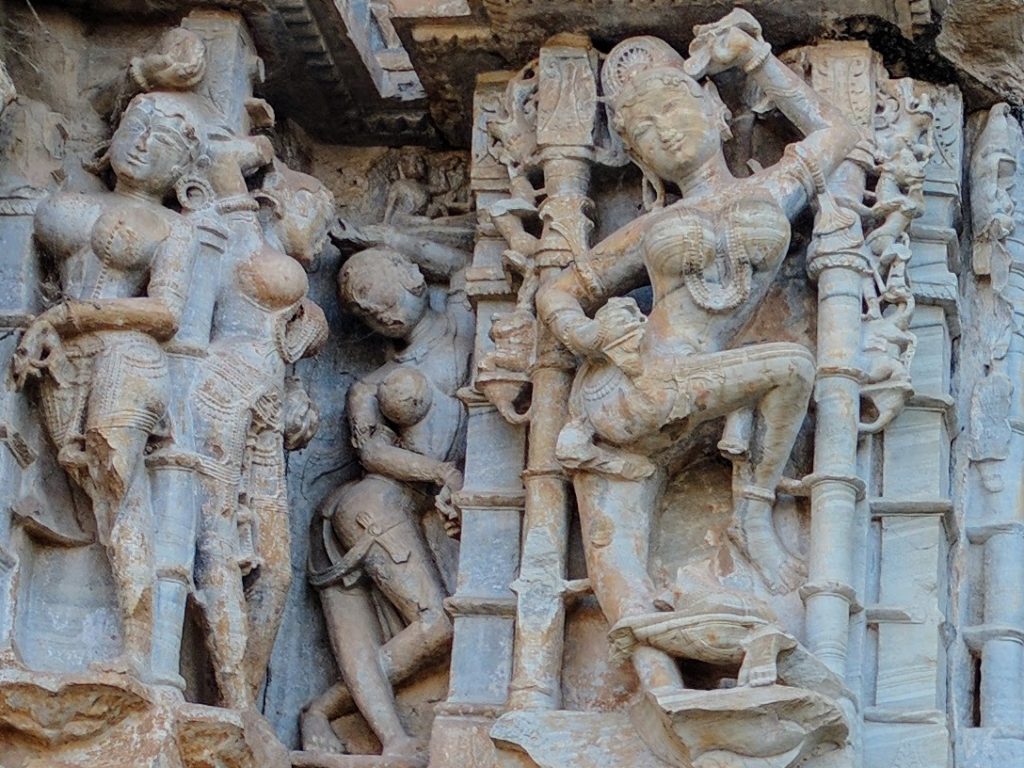
Udaipur (Sahelion Ki Bari) with early 18th century fountains that work entirely by gravity.
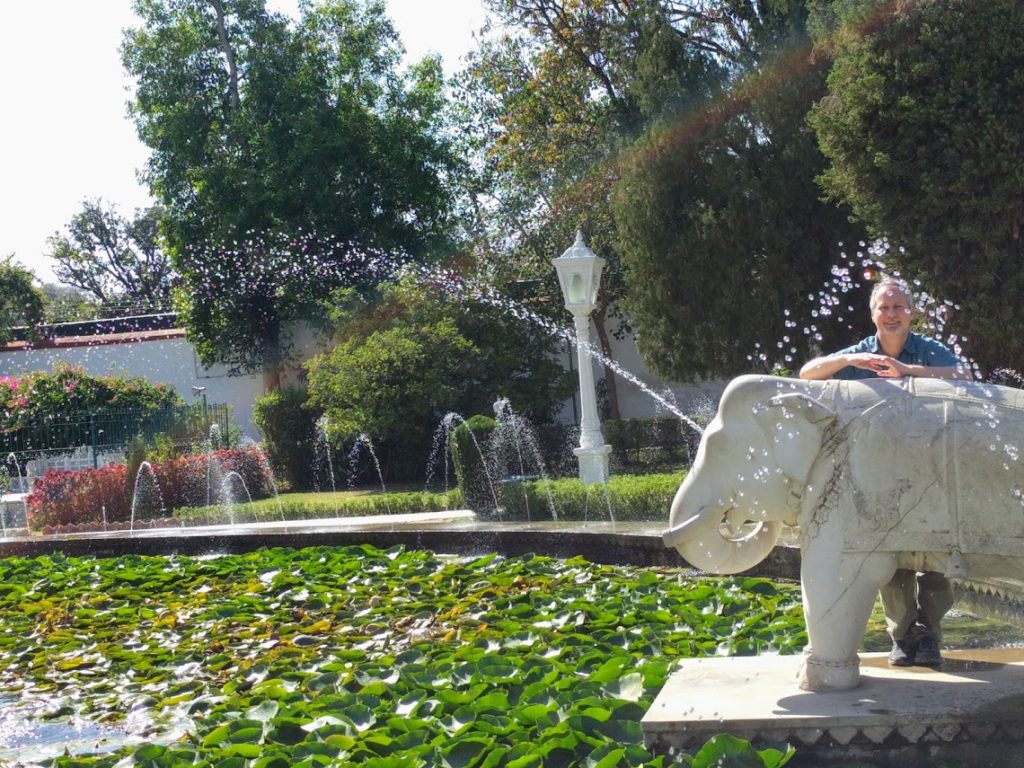
Ajanta caves.
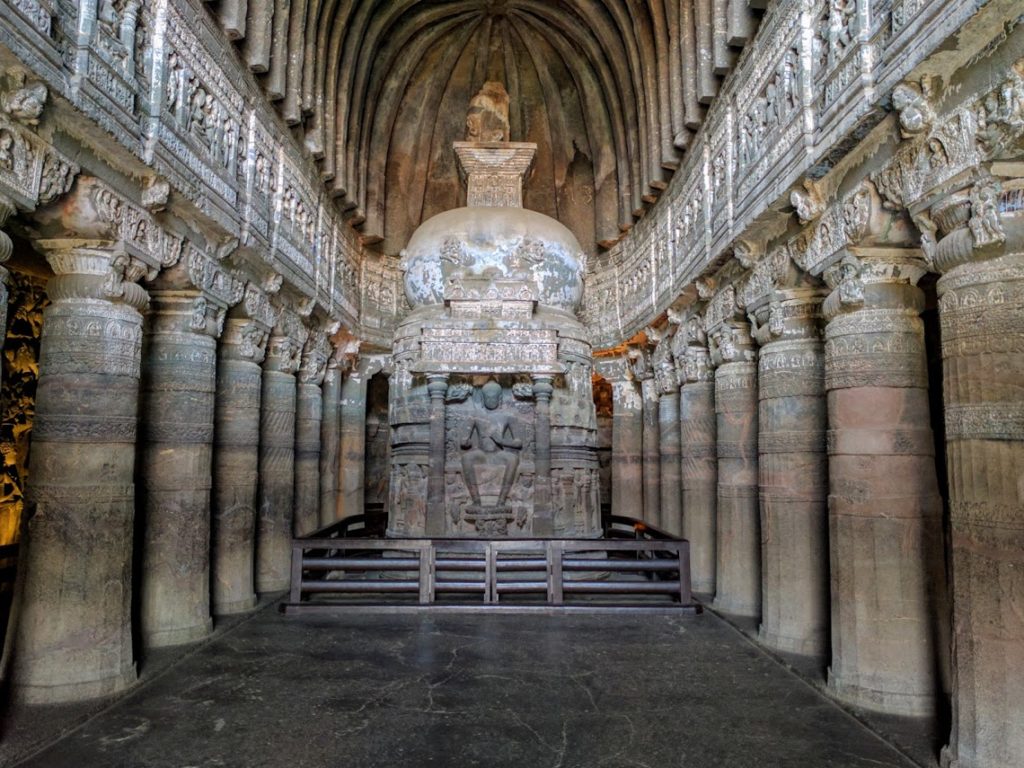
My new podcast with Ezra Klein
Here is part of Ezra’s description:
I had a simple plan: ask Cowen for his thoughts on as many topics as possible. And I think it worked out pretty well. We discuss everything from New Jersey to high school sports to finding love to smoked trout to nootropics to Thomas Schelling to Ayn Rand to social media to speed reading strategies to happy relationships to the disadvantages of growing up in Manhattan. And believe me when I say that is a small sampling of the topics we cover.
We also talk about Tyler’s new book, “The Complacent Class,” which argues, in true Cowenian fashion, that everything we think we know about the present is wrong, and far from being an age of rapid change and constant risk, we have become a cautious, even stagnant, society.
This as information dense a discussion as I’ve hosted on this podcast. I took a lot away from it, and I think you will too.
Here is the link.
A Visit to the Lasalgaon Onion Market
It’s a paradox of kinds that in the United States we use markets more than in other countries but as a people we are less likely to participate in a market. Of course, when we buy things at the supermarket we  are participating in a market but in posted-price markets it’s hard to see price formation and supply and demand in action. So when I travel abroad, I like to visit markets. (Tyler calls it GDP tourism).
are participating in a market but in posted-price markets it’s hard to see price formation and supply and demand in action. So when I travel abroad, I like to visit markets. (Tyler calls it GDP tourism).
The Lasalgaon onion market is Asia’s largest. It’s about four hours from Mumbai in Nashik district which is also well known for grape production. Twice a day during the season(s) onion farmers bring their small trucks and trailers filled with onions to auction. Farms in India are small, approximately 67% are one hectare (2.4 acres) or less and 99% are below 10 hectares. Thus, hundreds of trucks park in long lines that stretch into the distance. The farmers dump some of their onions onto the ground so the buyers can inspect for the type, size, moisture content and quality. An auctioneer then walks down the line and quickly auctions off the content of each truck. As we watched, one truck’s onion supply was bought for a buyer in Dubai, the next went to Malaysia, the next and highest quality went to France. The process is fast, fast, fast!
 We were guided in our adventure by Nanasaheb Patil, a highly respected businessperson and the chairman of the Agricultural Produce Market Committee, a group that runs the market and ensures the honesty of the auction process.
We were guided in our adventure by Nanasaheb Patil, a highly respected businessperson and the chairman of the Agricultural Produce Market Committee, a group that runs the market and ensures the honesty of the auction process.
Current onion prices are very low, below production cost, but high onion prices have brought down more than one national government so the farmers don’t get much of a hearing. When prices are high the government bans exports and blames farmers for hoarding (when prices are low as is true today, exports are allowed).
The onion crop from certain times of the year rots quickly. 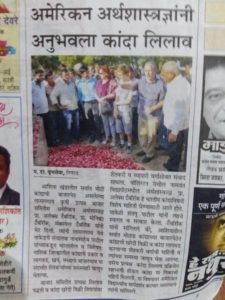 The government did build a very expensive irradiation facility to improve shelf life but the facility, which can process 10 tonnes of onions an hour, was only used for 3 hours of onion processing in a recent year! Although using the facility isn’t expensive it requires unloading, sacking and reloading tonnes of onions which renders it uneconomic (the facility is used for mango irradiation because mangoes exported to the US must be irradiated.)
The government did build a very expensive irradiation facility to improve shelf life but the facility, which can process 10 tonnes of onions an hour, was only used for 3 hours of onion processing in a recent year! Although using the facility isn’t expensive it requires unloading, sacking and reloading tonnes of onions which renders it uneconomic (the facility is used for mango irradiation because mangoes exported to the US must be irradiated.)
One thing I hadn’t expected was that our presence at the auction market was something of an event and led to a story and photo (you can probably spot my wife and son) in the local newspaper.
We also visited some of the local grape farms. You can get an idea about wages by noting that on this farm, which was exporting grapes, every single bunch was wrapped in newspaper to prevent sunburn.
A special hat tip to Milind Murugkar, engineer, writer, and long-time reader of MR who invited me to Nashik and arranged for us to meet our wonderful host Nanasaheb Patil.

Bengaluru [Bangalore] stops terror attacks with traffic jams
According to a report by Nikhil Gangadhar in the Deccan Herald, Bengaluru may be the first city in the world that stopped at least one terrorist attack using just bad traffic.
That’s right, you heard correctly…a terrorist attack may have been averted with just a traffic jam. Nikhil reports that a man named Habib Mia, arrested in Tripura and brought to Bengaluru last week, told police that terrorists who attacked IISc on December 28, 2005, also planned to attack other seminar events in parallel to tarnish India’s reputation.
However, an attacker who was travelling to the Indian Institute of Management on Bannerghatta Road apparently got caught in a traffic jam, and the seminar he was supposed to attack ended before he could get there.
What’s more, the terrorists also reportedly dropped a plan to attack an event at PES Institute of Technology because there was no easy escape route available.
Here is the full story, via Ashish Kulkarni.
Every conference should invite two hitchhikers
Recently I went to a (very good) conference. As a number of us got off the train and waited near the platform for a ride, we immediately recognized each other as belonging to the same event, even though we had not met each other before. We were short and tall, male and female, and of varying races, but still we all had “that look”; I leave it as an exercise for the reader to consider what that means.
It occurred to me that many conferences could try to be more diverse. No, I am not referring to gender or race or ethnicity, although that may be true as well. I am referring to personality types and life experiences. Perhaps each conference should have at least one or two people who are not driven to succeed, not the member of any elite group, and not assured of their standing in the world.
What then to select for? I wondered whether each conference ought not to invite a hitchhiker or two. Think about hitchhikers, at least as a group on average:
1. They are mobile and not so set in their ways. They do not evaluate everything in terms of its efficacy and productivity.
2. They are adventurous and willing to engage with strangers.
3. They have not sunk their assets into expensive homes or fancy cars.
4. They wish to see the world and have a minimum amount of restlessness, maybe more.
5. Superficially it may seem that hitchhikers are “stupider than average,” but I suspect relative to their demographics they are smarter than average.
6. They do not schedule their lives so very tightly.
7. Since the late 1970s, fewer people engage in hitchhiking, and this raises their intrinsic interest. They are trying to resurrect a dying form of social capital, still prevalent mainly in Cuba and Eastern Europe.
8. The groups skews male, but I wonder if any more so than conference attendees more generally.
Most of all, hitchhikers probably have some time to spare. Send out a car, and offer them a ride and a conference. Toss in $500 if need be. They still will be cheaper than reimbursing the travel costs for most of your guests. Furthermore, when it comes to “getting back,” they can, um…hitch a ride.
If you wish, give them the right to shout out “You must be on drugs!’ or “I wouldn’t give you a ride!” at least once each conference, without fear of being ejected or otherwise shamed.
Again, here is a video on hitchhikers. They are perhaps the least likely guests to complain about the conference accommodations.
The US Civil War, Globalization and the City of Bombay
The structure of Bombay is intimately tied to the history of the United States in ways that illustrate the long arc of globalization. At the heart of Bombay, around the Oval Maidan, on which cricket games are often played, one can see many of Bombay’s iconic Victorian buildings including the University of 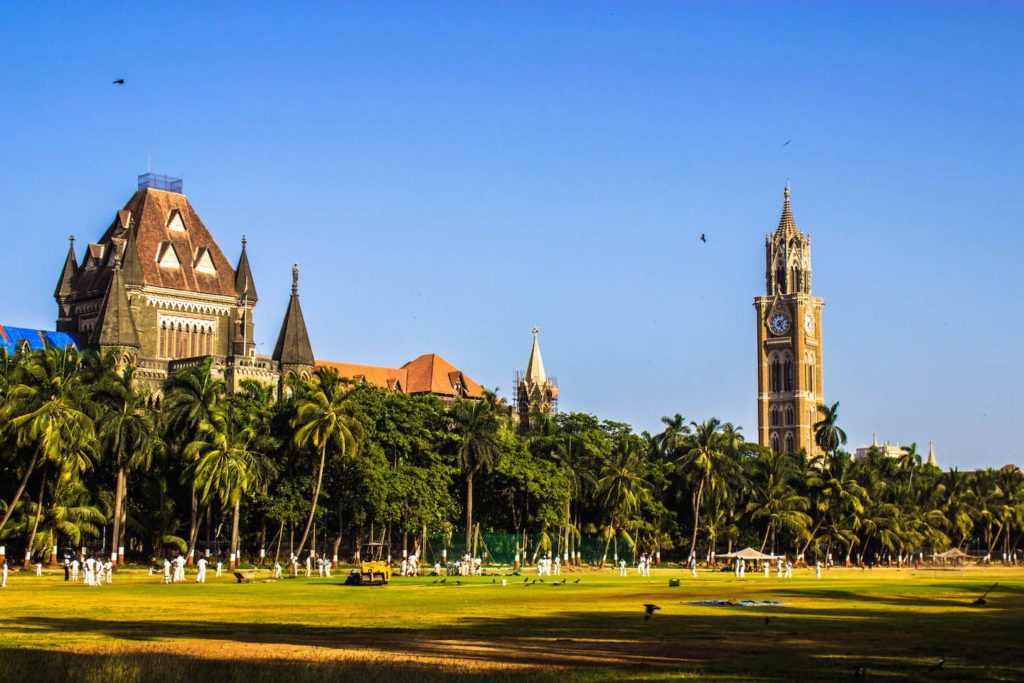 Bombay, the Bombay High Court and the Rajabai clock tower. These buildings and many others were begun in the late 1850s and 1860s during the Bombay boom; a boom brought about by America’s Civil War.
Bombay, the Bombay High Court and the Rajabai clock tower. These buildings and many others were begun in the late 1850s and 1860s during the Bombay boom; a boom brought about by America’s Civil War.
The U.S. South began the civil war by embargoing cotton exports and burning 2.5 million bales of cotton in order to create a shortage and bend the world to its will. The embargo didn’t lead to Britain’s support, however, and by the time the South realized it had shot itself in the foot the North imposed its own blockade. Cotton prices skyrocketed–between 1860 and 1863-1864 prices rose by a factor of four on average and at times by a factor of 10. As cotton exports from the United States fell, exports from Persia, Egypt and especially India boomed. As Sven Beckert put it:
The bombardment of Fort Sumter…announced that India’s hour had come.
In India farm land was switched over to cotton, railroads and telegraphs were built uniting cotton producing areas in Bihar with cotton’s chief trading center and port, Bombay. Production and exports boomed. Vast fortunes were made from the cotton trade and the speculation it engendered; fortunes that were plowed into universities, libraries and many of the great buildings that mark Mumbai today. In fact, the Back Bay Reclamation project began at this time so some of the very ground that Mumbai sits upon has its roots in the American Civil War.
Influences flowing in the reverse direction were at least as strong. The decline in cotton exports from the South created mass unemployment in Great Britain and it was not out of the question that Britain would side with the South. Beckert quotes the investment bank Baring Brothers:
In the spring of 1862, Baring Brothers Liverpool expressed their view that war between the United States and Great Britain was less likely “provided we get a large import from India.”
Fortunately, increased Indian cotton production alleviated the “Cotton famine” and reduced the South’s bargaining power. Thus, “Indian cultivators and merchants played a small role in contributing to Northern victory in the Civil War.”
General Robert Lee’s surrender at Appomattox ended the Bombay boom. As news of Lee’s surrender spread, market prices crashed and speculative fortunes were lost. The railways and the telegraphs, however, now linked India to the world. And at the heart of Bombay, the universities, the libraries and the civic institutions endured making Bombay, Urbs Prima in Indis.